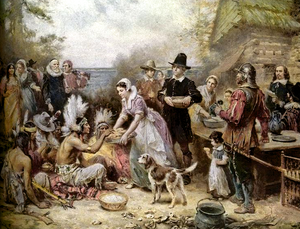Thanksgiving: Difference between revisions
PurpleRain (talk | contribs) Removal of copyrighted material (copied from http://agr.mt.gov/dept/AgDay/lesson%20plan%20-%20let%27s%20celebrate.pdf) |
Formatted headings. |
||
| Line 31: | Line 31: | ||
The history of Thanksgiving in Canada goes back to an English explorer, [[Martin Frobisher]], who had been trying to find a northern passage to the Orient. He did not succeed but he did establish a settlement in Canada. In the year 1578, he held a formal ceremony, in what is now the province of [[Newfoundland and Labrador]], to give thanks for surviving the long journey. This is considered the first Canadian Thanksgiving, and the first Thanksgiving to have taken place in North America. Other settlers arrived and continued these ceremonies. Frobisher was later knighted and had an inlet of the Atlantic Ocean in northern Canada named after him — [[Frobisher Bay]]. |
The history of Thanksgiving in Canada goes back to an English explorer, [[Martin Frobisher]], who had been trying to find a northern passage to the Orient. He did not succeed but he did establish a settlement in Canada. In the year 1578, he held a formal ceremony, in what is now the province of [[Newfoundland and Labrador]], to give thanks for surviving the long journey. This is considered the first Canadian Thanksgiving, and the first Thanksgiving to have taken place in North America. Other settlers arrived and continued these ceremonies. Frobisher was later knighted and had an inlet of the Atlantic Ocean in northern Canada named after him — [[Frobisher Bay]]. |
||
== |
==References== |
||
<references/> |
<references/> |
||
''Thanksgiving: An American Holiday, An American History,'' by Diana Karter Appelbaum |
''Thanksgiving: An American Holiday, An American History,'' by Diana Karter Appelbaum |
||
==External |
==External links== |
||
* [http://www.pch.gc.ca/progs/cpsc-ccsp/jfa-ha/action_e.cfm Canadian Heritage: Thanksgiving and Remembrance Day]{{commons}} |
* [http://www.pch.gc.ca/progs/cpsc-ccsp/jfa-ha/action_e.cfm Canadian Heritage: Thanksgiving and Remembrance Day]{{commons}} |
||
Revision as of 19:35, 30 July 2007

Thanksgiving, or Thanksgiving Day, is an annual one-day holiday to give thanks at the end of the harvest season. In the United States, Thanksgiving is celebrated on the fourth Thursday of November. In Canada, Thanksgiving is celebrated on the second Monday in October.
United States
Traditional celebration
In the United States, certain kinds of food are traditionally served at Thanksgiving meals. First and foremost, turkey is usually the featured item on any Thanksgiving feast table (so much so that Thanksgiving is sometimes referred to as "Turkey Day"). Stuffing, mashed potatoes with gravy, sweet potatoes, cranberry sauce, corn, other fall vegetables, yams and pumpkin pie are commonly associated with Thanksgiving dinner. All of these primary dishes (except yams) are actually native to the Americas and were introduced as a new food source to the Europeans when they arrived.
History of Thanksgiving in the United States
The Virginia colony
A collective prayer of thanksgiving was held in the Virginia Colony on December 4, 1619 near the current site of Berkeley Plantation, where celebrations are still held each year on the first Sunday in November.[1]
Pilgrims
The early settlers of Plymouth Colony in Massachusetts were particularly thankful for Squanto, the Native American who taught them how to catch eel, grow corn and who served as an interpreter for them (Squanto had learned English as a slave in Europe). Without Squanto's help the settlers might not have survived in the new world.
These settlers (who later came to be called the "Pilgrims") set apart a day to celebrate at Plymouth immediately after their first harvest, in 1621.
After their first harvest, the colonists of the Plymouth held a celebration of food, feasting, and praising God in the fall of 1621. Indian chiefs Massassoit, Squanto and Samoset joined in the celebration with ninety of their men in the three-day event.
Canada
Traditional celebration
In Canada, Thanksgiving is a three-day weekend (although some provinces choose to observe a four day weekend, Friday–Monday).
As a liturgical festival, Thanksgiving in Canada corresponds to the English and continental European Harvest festival, with churches decorated with cornucopias, pumpkins, corn, wheat sheaves and other harvest bounty, English and European harvest hymns sung on the Sunday of Thanksgiving weekend and scriptural lections drawn from the biblical stories relating to the Jewish harvest festival of Sukkot.
While the actual Thanksgiving holiday is on a Monday, Canadians might eat their Thanksgiving meal on any day of the three day weekend. In Canada, Thanksgiving is often celebrated with family, it is also often a time for weekend getaways for couples to observe the autumn leaves, spend one last weekend at the cottage or participate in various outdoor activities such as hiking, fishing and hunting.
History of Thanksgiving in Canada
The history of Thanksgiving in Canada goes back to an English explorer, Martin Frobisher, who had been trying to find a northern passage to the Orient. He did not succeed but he did establish a settlement in Canada. In the year 1578, he held a formal ceremony, in what is now the province of Newfoundland and Labrador, to give thanks for surviving the long journey. This is considered the first Canadian Thanksgiving, and the first Thanksgiving to have taken place in North America. Other settlers arrived and continued these ceremonies. Frobisher was later knighted and had an inlet of the Atlantic Ocean in northern Canada named after him — Frobisher Bay.
References
- ^ "First Thanksgiving". Virginia Tourism Corporation. Retrieved 2006-11-21.
Thanksgiving: An American Holiday, An American History, by Diana Karter Appelbaum
